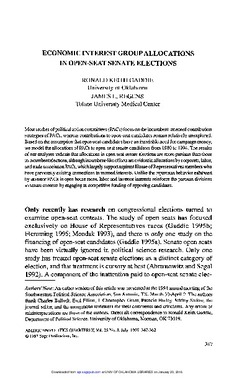| dc.contributor.author | Ronald Keith Gaddie | |
| dc.contributor.author | James L. Regens | |
| dc.date.accessioned | 2016-01-14T19:53:43Z | |
| dc.date.accessioned | 2016-03-30T15:33:08Z | |
| dc.date.available | 2016-01-14T19:53:43Z | |
| dc.date.available | 2016-03-30T15:33:08Z | |
| dc.date.issued | 1997-07-01 | |
| dc.identifier.citation | Gaddie, R. K., & Regens, J. L. (1997). Economic Interest Group Allocations in Open-Seat Senate Elections. American Politics Research, 25(3), 347-362. doi: 10.1177/1532673x9702500305 | en_US |
| dc.identifier.uri | https://hdl.handle.net/11244/25412 | |
| dc.description.abstract | Most studies of political action committees (PACs) focus on the incumbent-oriented contribution strategies of PACs, whereas contributions to open-seat candidates remain relatively unexplored. Based on the assumption that open-seat candidates have an insatiable need for campaign money, we model the allocations of PACs to open-seat senate candidates from 1980 to 1994. The results of our analyses indicate that allocations in open-seat senate elections are more partisan than those in incumbent elections, although incumbent-like effects are evident in allocations by corporate, labor, and trade association PACs, which largely support aspirant House of Representatives members who have previously existing connections to monied interests. Unlike the bipartisan behavior exhibited by investor PACs in open house races, labor and investor interests reinforce the partisan divisions in senate contests by engaging in competitive funding of opposing candidates. | en_US |
| dc.language.iso | en_US | en_US |
| dc.publisher | American Politics Research | |
| dc.title | Economic Interest Group Allocations in Open-Seat Senate Elections | en_US |
| dc.type | Research Article | en_US |
| dc.description.peerreview | Yes | en_US |
| dc.description.peerreviewnotes | https://us.sagepub.com/en-us/nam/manuscript-submission-guidelines | en_US |
| dc.identifier.doi | 10.1177/1532673x9702500305 | en_US |
| dc.rights.requestable | false | en_US |
